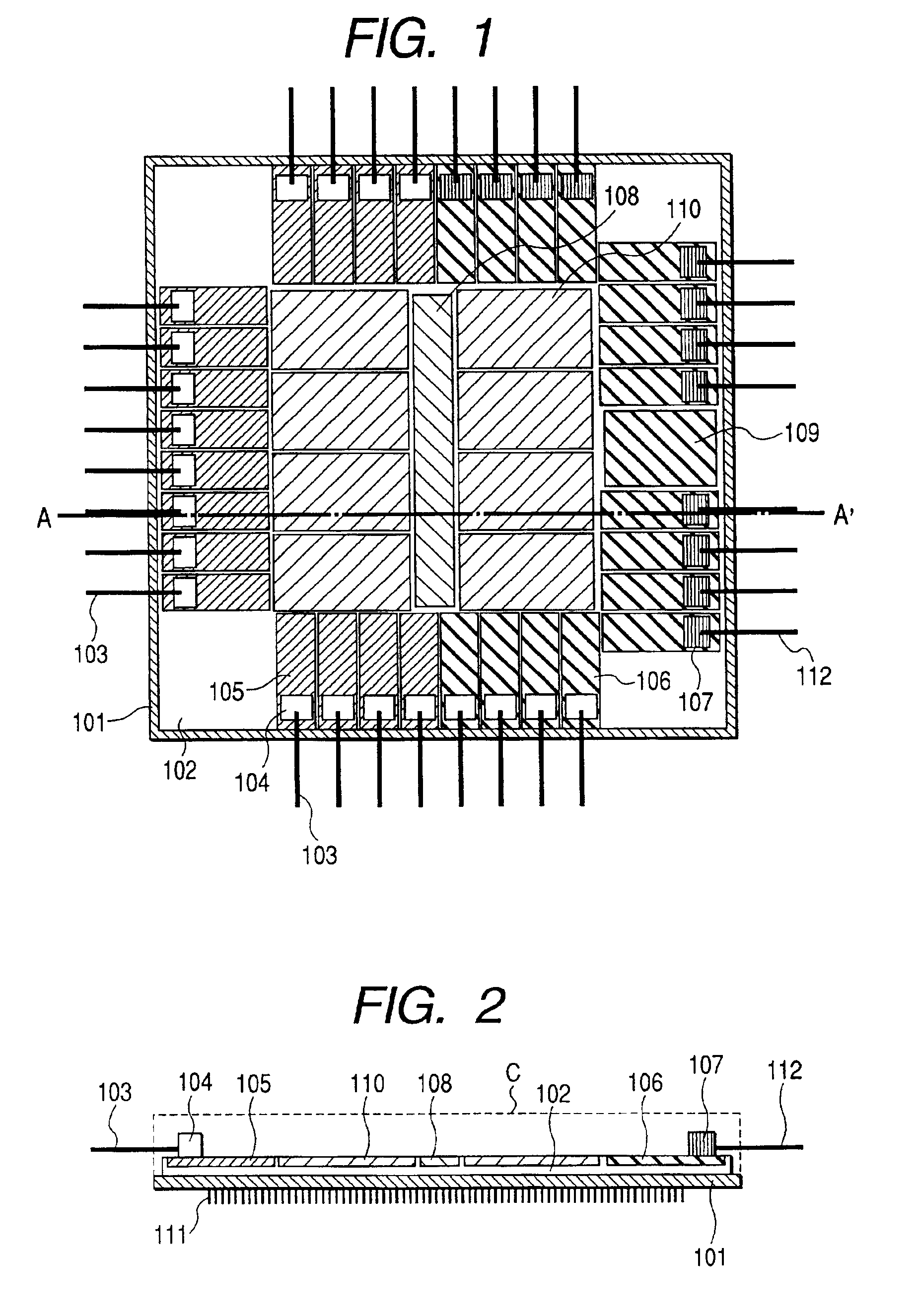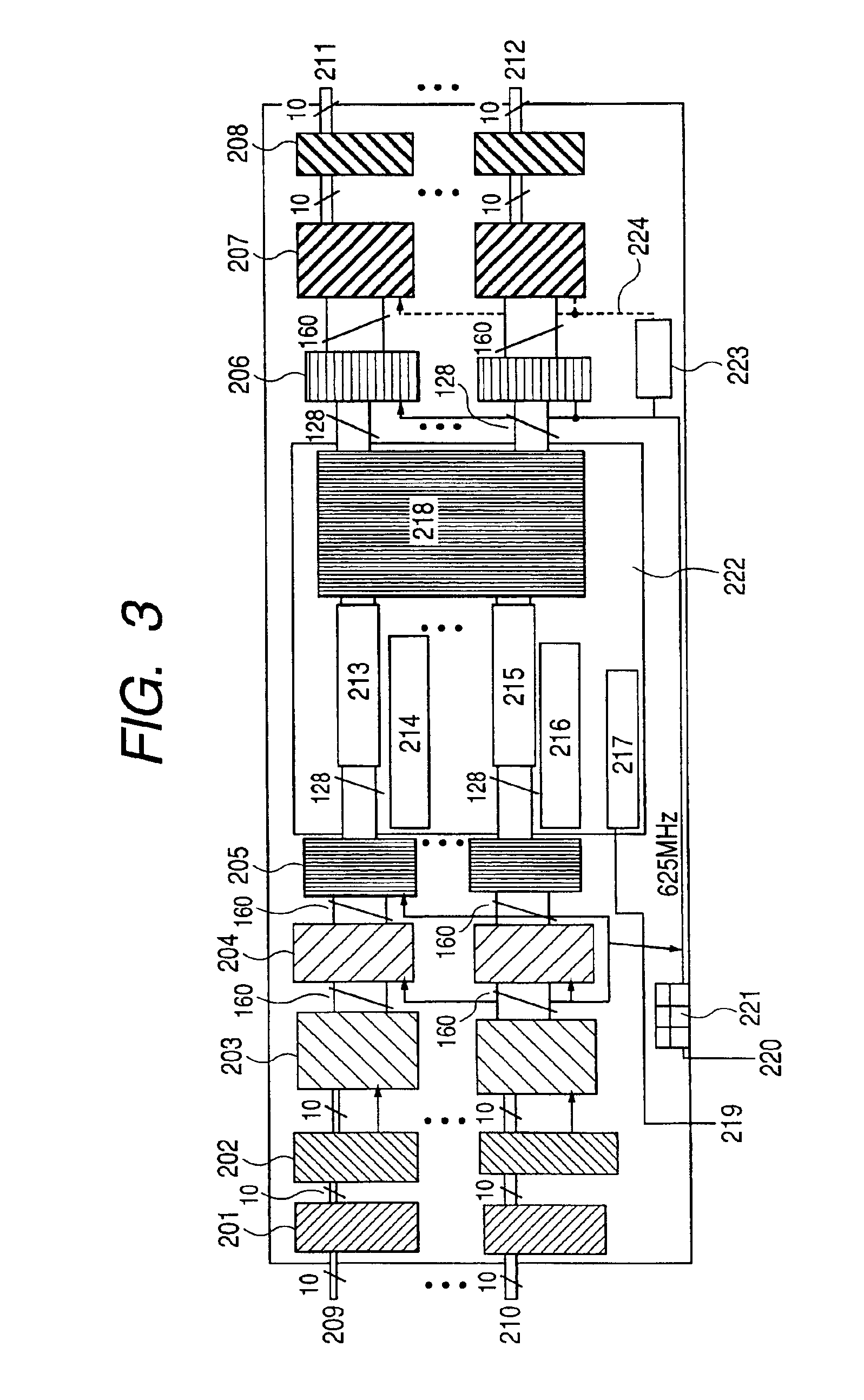Wavelength division multiplexed optical interconnection device
a multi-wavelength, optical interconnection technology, applied in the direction of visual presentation using printers, semiconductor lasers, instruments, etc., can solve the problems of 2.5 ghz, difficult manufacturing cost, and large increase in the number of wirings, so as to facilitate implementation, improve the delay characteristics of various signals employed, and increase the data throughput of the optical interconnection device
- Summary
- Abstract
- Description
- Claims
- Application Information
AI Technical Summary
Benefits of technology
Problems solved by technology
Method used
Image
Examples
first embodiment
[0037]Preferred embodiments of the present invention will be described with reference to FIGS. 1 through 5. FIG. 1 is a plan view for describing a layout of an essential portion of a wavelength division multiplexed optical interconnection device according to the present invention, which is integrated on one semiconductor substrate or within one package. FIG. 2 is a cross-sectional view illustrating an essential portion taken along line A-A′ in FIG. 1. FIG. 3 is a circuit functional block diagram illustrating an essential portion which constitutes the inside of a signal processing LSI of the wavelength division multiplexed optical interconnection device, respectively. FIG. 4 is an enlarged view illustrating an essential portion of an optical input unit mounted on a printed circuit board. FIG. 5 is an enlarged view illustrating an essential portion of an optical output unit placed on the printed circuit board, respectively. Incidentally, the planes of the optical input and output unit...
second embodiment
[0063]A packing structure shown in FIG. 6 is adopted in place of the structure of the optical data input unit described in FIG. 4 in the first embodiment of the present invention. A description will be made of a second embodiment, which adopts a packing structure shown in FIG. 7 in place of the structure of the optical data output unit described in FIG. 5. The second embodiment is similar in electric circuit structure to the first embodiment. Incidentally, the planes of the optical input and output units are shown on the upper sides in FIGS. 6 and 7 and the cross-sections thereof are shown on the lower sides in FIGS. 6 and 7.
[0064]The second embodiment has a structure wherein fibers 503 and 609 and fiber receptacles 501 and 611 in which optical parallel signals are inputted and outputted from within a device, are respectively bonded to the surfaces of a mounting printed boards 513 and 613. As shown in FIG. 6, an optical single mode fiber 503 placed onto the board 513 is bent in an S...
third embodiment
[0067]A packing structure describe in FIG. 8 is adopted in place of the structure of the optical data input unit described in FIG. 4 in the first embodiment of the present invention. A description will be made of a third embodiment which adopts a packing structure described in FIG. 9 in place of the structure of the optical data output unit described in FIG. 5. Incidentally, the third embodiment is similar in electric circuit structure to the first embodiment. Incidentally, the planes of the optical input and output units are shown on the upper sides in FIGS. 8 and 9, and the cross-sections thereof are shown on the lower sides in FIGS. 8 and 9.
[0068]In the third embodiment, optical parallel signals are respectively inputted to and outputted from the device through optical fibers 702 and 801 embedded into mounting printed boards 713 and 811 without being done via fibers on the mounting printed boards. The Optical fibers 702 and 810 embedded into the boards 713 and 811 in the horizont...
PUM
 Login to View More
Login to View More Abstract
Description
Claims
Application Information
 Login to View More
Login to View More - R&D
- Intellectual Property
- Life Sciences
- Materials
- Tech Scout
- Unparalleled Data Quality
- Higher Quality Content
- 60% Fewer Hallucinations
Browse by: Latest US Patents, China's latest patents, Technical Efficacy Thesaurus, Application Domain, Technology Topic, Popular Technical Reports.
© 2025 PatSnap. All rights reserved.Legal|Privacy policy|Modern Slavery Act Transparency Statement|Sitemap|About US| Contact US: help@patsnap.com



